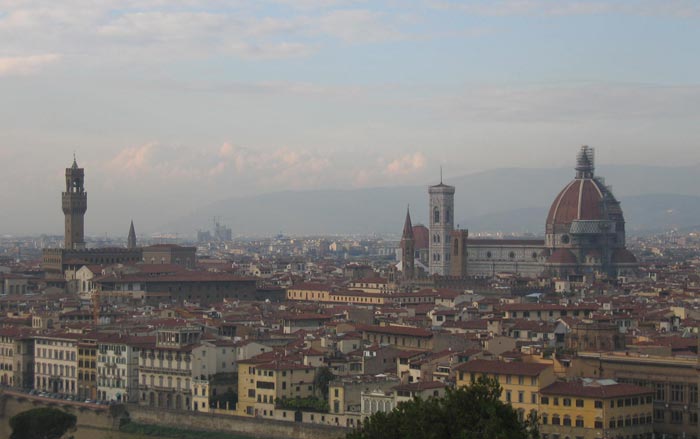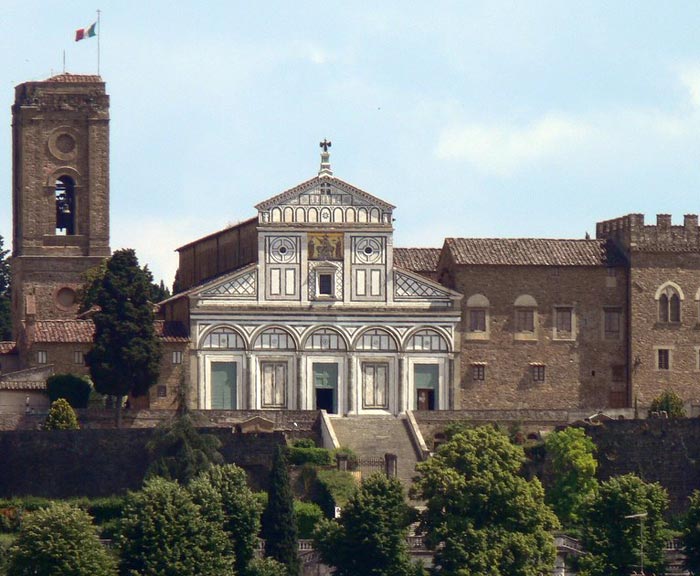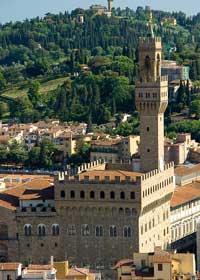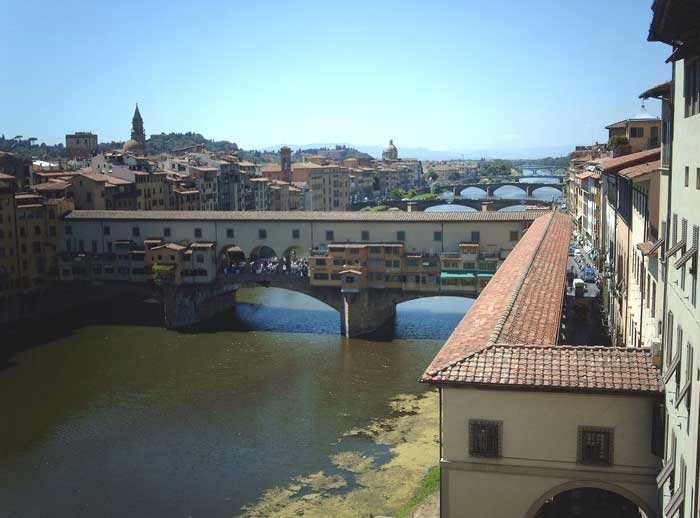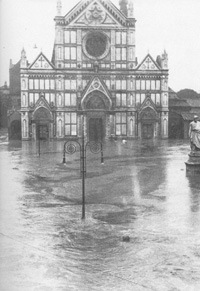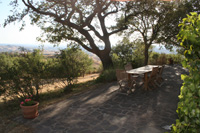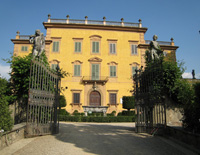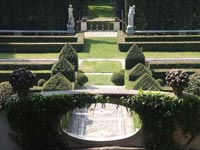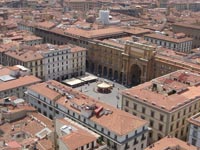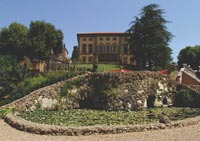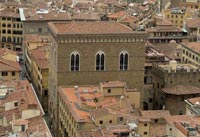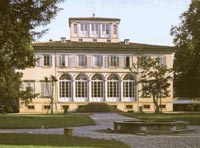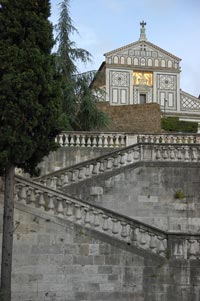| |
|
San Miniato al Monte
|
|
|
|
San Miniato al Monte
|
The Basilica of San Miniato al Monte is one of the oldest churches in Florence and is frequently called the finest Romanesque basilica in all of Italy. The church as we know it today was started around 1018 and took over one hundred years to complete. St. Minias was possibly from Armenia and believed to have been martyred around 250 (he was beheaded during the anti-Christian persecutions of the Emperor Decius and was said to have picked up his head, crossed the Arno and walked up the hill of Mons Fiorentinus to his hermitage and buried on this hillside). The church is in a wonderful state of preservation and there are several important works inside, including a tabernacle attributed to Rossellino, the tomb of the Cardinal of Portugal with works by Rossellino, Della Robbia and others, frescoes by Agnolo Gaddi, and an amazing fresco cycle of the life of St. Benedict by Spinello Aretino, to name just some of them.
Art in Tuscany | Florence | Basilica of San Miniato al Monte |
|
|
|
Santa Croce
|
Santa Croce is one of the oldest Franciscan basilicas and, in terms of its dimensions, also one of the most magnificent. Adjacent to the church is the convent complex with its two cloisters, the novices' quarters, the Chapter Room, better known as the Pazzi Chapel, and the refectory, which is now the premises of the Museum and houses famous works originating from the church and the cloisters.
Built in 1294, to a design by the great architect Arnolfo di Cambio, the Basilica has lived through seven centuries of history, augmenting its artistic heritage as a result of exceptional contributions, to the point of becoming one of the best-loved and most visited sites in Florence.
Everything in the church is of the very highest quality: the frescoes executed through the contributions of Giotto, Maso di Banco, Taddeo Gaddi, Giovanni da Milano and Agnolo Gaddi; the monumental crosses and the polyptychs, the splendid fourteenth-century windows; the Renaissance architecture created by Michelozzo and Brunelleschi; the fifteenth-century sculptural works – tombs, altars and pulpits – by the greatest Florentine masters, including Donatello, Antonio and Bernardo Rossellino, Desiderio da Settignano and Benedetto da Maiano.
Later, in the second half of the sixteenth century, Santa Croce was involved in an architectural and iconographic programme inspired by the principles of the Counter-Reformation, involving the erection of large altars embellished with paintings by the greatest Tuscan artists of the time.
However, it was with the construction of the tomb of Michelangelo that the Basilica confirmed its vocation to house “the urns of the great” and to become the Pantheon of Italian glories.
In the course of the nineteenth century, alongside the sepulchres celebrated by Ugo Foscolo, private tombs inspired by a romantic mourning for lost affections also found their place in the Basilica, and above all in the cloister.
In the nineteenth century the facade and the campanile were built, and the monument to Dante Alighieri was set up in the square.
The square of Santa Croce is also a centre of civic life, emblematic in the history and urban layout of Florence; it continues to be the site of public events and historic re-enactments, such as the football in costume.
Over the centuries, the Basilica and the adjacent convent have witnessed the evolution of the religious life of the Franciscan community, from its very origins when the fervour of devotion to the “Poor Man” of Assisi favoured the development of a major centre of religion and study, right up to the time of the Suppressions, when the complex became public property (1866).
The Opera di Santa Croce, a lay institution which over the course of the centuries has presided over the construction, maintenance and restoration of the monument, continues to be responsible for maintaining the immense heritage in the best possible condition and enabling it to be visited and enjoyed by millions of visitors.
Churches in Florence | Santa Croce |
|
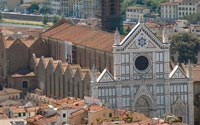
Firenze, Santa Croce
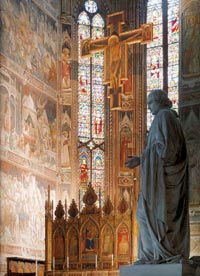
Santa Croce. Agnolo Gaddi and his assistants began decorating the Great Chapel and its walls in the 1380s
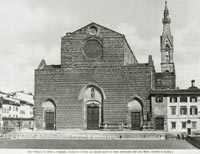
The old facade of Santa Croce |
Basilica of Santa Maria Novella
|
Santa Maria Novella is a church in Florence, situated just across the main railway station which shares its name. Chronologically, it is the first great basilica in Florence, and is the city's principal Dominican church. The church, the adjoining cloister, and chapterhouse contain a store of art treasures and funerary monuments. Especially famous are frescoes by masters of Gothic and early Renaissance. They were financed through the generosity of the most important Florentine famiilies, who ensured themselves of funerary chapels on consecrated ground. This church was called Novella (New) because it was built on the site of the X-century oratory of Santa Maria delle Vigne. When the site was assigned to Dominican Order in 1221, they decided to build a new church and an adjoining cloister. The church was designed by two Dominican friars, Fra Sisto Fiorentino and Fra Ristoro da Campi. Building began in the mid-XIII century (about 1246), and was finished about 1360 under the supervision of Friar Iacopo Talenti with the completion of the Romanesque-Gothic bell tower and sacristy. At that time, only the lower part of the Tuscan Gothic facade was finished. On a commission from Giovanni di Paolo Rucellai, a local textile merchant, Leone Battista Alberti designed the upper part of the inlaid black and white marble facade of the church (1456-1470). Alberti attempted to bring the ideals of humanist architecture, proportion and classically-inspired detailing, to bear on the design while also creating harmony with the already existing medieval part of the facade. His contribution consists of a broad frieze decorated with squares and everything above it, including the four white-green pilasters and a round window, crowned by a pediment with the Dominican solar emblem, and flanked on both sides by enormous S-curved volutes.
The vast interior is based on a basilica plan, designed as a Latin cross and is divided into a nave, two aisles with stained-glass windows and a short transept. There is a trompe l'oeil-effect by which this nave towards the apse seems longer than its actual length. The interior also contains corinthian columns that were inspired by the Classical era of Greek and Roman times. The stained-glass windows date from the XIV and XV century, such as XV-century Madonna and Child and St. John and St. Philip (designed by Filippino Lippi), both in the Filippo Strozzi Chapel. Some stained glass windows have been damaged in the course of centuries and had to be replaced. The pulpit, commissioned by the Rucellai family in 1443, was designed by Filippo Brunelleschi and executed by his adopted child Andrea Cavalcanti. This pulpit has a particular significance, because from this pulpit the first attack came on Galileo Galilei, leading eventually to his indicment. The Holy Trinity, situated almost halfway in the left aisle, is a pioneering early renaissance work of Masaccio, showing his new ideas about perspective and mathematical proportions. Its meaning for the art of painting can easily be compared by the importance of Brunelleschi for architecture and Donatello for sculpture. The Filippo Strozzi Chapel is situated on the right side of the main altar. The Strozzi Chapel was the place where the first tale of the Decamerone by Giovanni Boccaccio began, when seven ladies decided to leave the town, and flee fom the Black Plague to the countryside. The choir (or the Tornabuoni Chapel) contains another series of famous frescoes, by Domenico Ghirlandaio and his apprentice the young Michelangelo (1485-1490). In the end of the nave, at a height of 45 meters, there is the Crucifix by Giotto (dated back around 1290), since 2001 after twelve years of restoration, in the position where probably it was until 1421.
Churches in Florence | Basilica of Santa Maria Novella
|
|
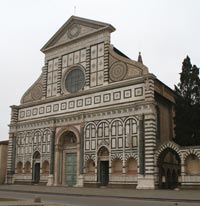
Basilica of Santa Maria Novella
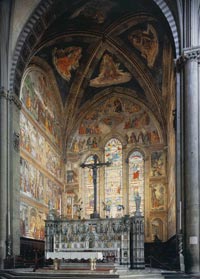 The Tornabuoni Chapel The Tornabuoni Chapel
|
| |
|
| |
|
|
Basilica di Santa Maria del Fiore
|
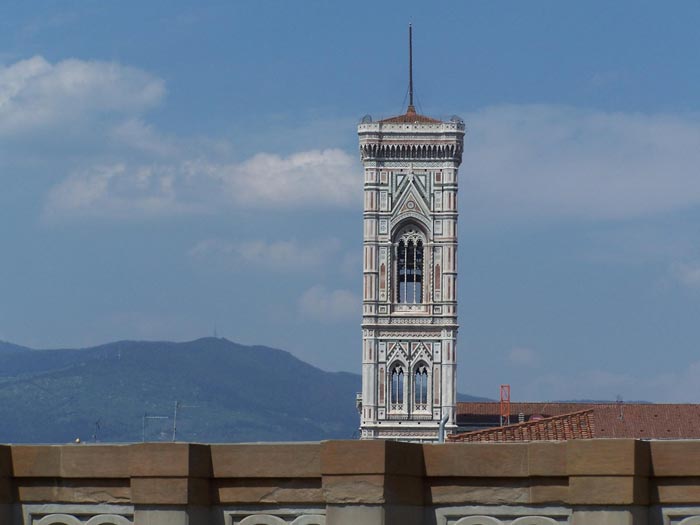 |
The Campanile | Giotto's Tower
|
The Basilica di Santa Maria del Fiore is the cathedral church (Duomo) of Florence, Italy, begun in 1296 in the Gothic style to the design of Arnolfo di Cambio and completed structurally in 1436 with the dome engineered by Filippo Brunelleschi. The exterior of the basilica is faced with polychrome marble panels in various shades of green and pink bordered by white and has an elaborate 19th century Gothic Revival facade by Emilio De Fabris.
When the mosaic decoration of the Baptistery was nearly complete, in the last decades of the 13th century, the Florentine government decided to build a new cathedral. In 1331, the Commune of Florence established that the Wool Merchants Guild, in practically total autonomy, would shoulder the burden and the honor of superintending the construction of the new Duomo, just as the Wool Workers Guild had done for the Baptistery since the mid XII century. The old duomo, dedicated to Santa Reparata, was "crumbling with age", as a document of the time attests. Next to the now "lovely" Saint John's, moreover, Santa Reparata seemed "very crude", as Giovanni Villani, a 14th-century writer, tells us. And in that era of dramatic population growth, the old cathedral was "small in comparison to so great a city", according to Villani. Thus the dream of an enormous church, far bigger than the cathedrals of Pisa and Siena, the rival Tuscan cities, was born. Florence wanted her Duomo to be grander in size and in exterior adornment, "all in marble and with carved figures" (reliefs and statues), as Villani says.
In 1412 the new name of Santa Maria del Fiore (Our Lady of the Flower, or 'of Florence') was officially assigned to the magnificent church that by then had arisen on the remains of the earlier basilica. In 1420, Pope Martin V conferred the privileges of a metropolitan church, and Santa Maria del Fiore was finally consecrated on March 25, 1436, by Pope Eugenius IV.
Entering the Cathedral, one is struck by the building's vastness and the sobriety of its furnishings. The color and rich patterning of the exterior, which serve to relate the mass of the structure to the smaller scale of surrounding buildings, here give way to a simplicity that underscores the titanic dimensions of this church (the largest in Europe when it was completed in the 15th century; 153 meters long, 90 wide at the crossing, and 90 meters high from pavement to the opening of the lantern).
Donatello designed the stained-glass window (Coronation of the Virgin) in the drum of the dome (the only one that can be seen from the nave).
The Museo dell'Opera del Duomo was originally a Cathedral workshop founded in 1296 to oversee construction of the Florence Cathedral and the Giotto Bell Tower.
The courtyard is enclosed to show off -- under natural daylight, as they should be seen -- Lorenzo Ghiberti's original gilded bronze panels from the Baptistery's Gates of Paradise, which are being displayed as they're slowly restored. On the way up the stairs, you pass Michelangelo's Pietà (1548-55), his second and penultimate take on the subject, which the sculptor probably had in mind for his own tomb.
The top floor of the museum houses the Prophets carved for the bell tower, the most noted of which are the remarkably expressive figures carved by Donatello: the drooping, aged face of the Beardless Prophet; the sad, fixed gaze of Jeremiah; and the misshapen ferocity of the bald Habakkuk (known to Florentines as Lo Zuccone — pumpkin head). Mounted on the walls above are two putty-encrusted marble cantorie (choir lofts).
Churches in Florence | The Duomo of Santa Maria del Fiore
Museo dell'Opera del Duomo | www.operaduomo.firenze.it
|
|

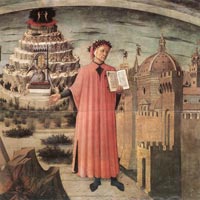
Domenico di Michelino, Dante and the
Three Kingdoms
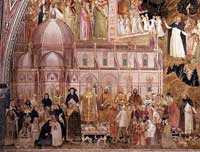
Florence Cathedral as it appears in a fresco by Andrea di Bonaiuto, painted in the 1390s, before the commencement of the dome
|
Loggia del Bigallo
|
|
|
 |
The Bigallo Madonna della Misericordia is depicted with the oldest known view of Florence, from 1342, including the Baptistery and an interesting view of the Cathedral during the construction of Santa Maria del Fiore. The old cathedral of Santa Reparata was still standing so that here we can pick out its saddle roof, two belltowers and lateral single light windows. Parts of Giotto's Belltower and the facade of Santa Maria del Fiore, as it had been conceived and left by Arnolfo at the time of his death in 1302, can also be seen.
|
Situated on the corner of the piazza of the Duomo and via Calzaioli, the mid-14th century Loggia del Bigallo has been a small museum since 1904. Even from outside, you can admire the frescoed building, but heading inside will give you a chance to see the much deteriorated but famous fresco of the Madonna della Misericordia, an image of the Virgin Mary with her cape encompassing her devotees (in this case the entire city) who are surrounded underneath and around her. The Bigallo Madonna is depicted with the oldest known view of Florence, from 1352.
Since 1998 the Loggia del Bigallo has been run by the Museo of the Opera del Duomo. Its beginnings, however, were as the main seat of the Misericordia, a catholic confraternity founded in Florence in the 13th century to help those in need, which at the time consisted of mostly people affected by the Plague.
The Madonna of Mercy, painted by the Bernardo Daddi school in 1342, is one of the most important keys for unlocking the vocation and for deepening the meaning of Florence. The Madonna wears a crown like that of the Empress Matilda, with the saving Tau in blood, and it is she who protects the city with the weapons of the acts of mercy as Jesus had listed them in the Gospel, these acts being given in the medallions of her mantle that contain these words.
Firenze | Florence | Loggia del Bigallo
Art in Tuscany | Madonna della Misericordia | Madonna of Mercy
|
|
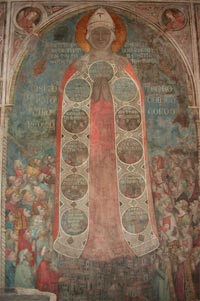
The Madonna della Misericordia, an anonymous 14th century fresco in the Bigallo, Florence. |
|
| |
|
The National Museum has its setting in one of the oldest buildings in Florence that dates back to 1255. Initially the headquarters of the Capitano del Popolo (Captain of the People) and later of the Podestà, the palace became, in the sixteenth century, the residence of the Bargello that is of the head of the police (from which the palace takes its name) and was used as prison during the whole 18th century.
The large 14th century hall on the first floor displays some works by Donatello (1386-1466) including the early marble David, the St. George moved to this location from the niche in Orsammichele, the more mature and ambiguous bronze David, the Atys. and the Marzocco, originally installed on the battlements of Palazzo Vecchio.
The works of the master are surrounded by the most delicate works of his pupils Desiderio da Settignano (c. 1430-1464) and Antonio Rossellino (c. 1427-1479). |
|
|
|
| |
|
The Church of Ognissanti or Chiesa di Ognissanti, one of the first Baroque churches in Florence, dates back to a 13th century. The church was founded in 1256 by the Umiliati, a Benedictine order who played a very significant role in the development of the wool industry in Florence. They moved into the city in the 13th century, bringing with them certain techniques for improving the quality of cloth, and established their workshops next to the Arno, a short distance from their convent. In the middle of the 16th century the church was taken over by the Franciscans.
Above the portal is a lunette of the 'Coronation of the Virgin' in glazed terracotta. It is thought to be by Benedetto Buglioni, who was almost the only decent artist working in this medium following the halt in production by the Della Robbia workshop, in the early part of the 16th century.
The famous painting of The Maesta by Giotto, which dominates the first room of the Uffizi, was painted for the high altar of the Ognissanti in, or around, 1310. It is worth popping into the church just to see the beautiful fresco of St Augustine (1480) by Botticelli. The fresco (detached) can be found half way along the nave on the right hand side. On the opposite side of the nave is a fresco (detached) of St Jerome (1480) by Ghirlandaio. |
|
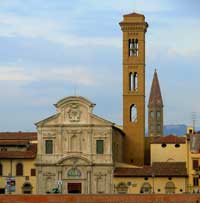
Chiesa di Ognissanti
|
| A small round stone in a chapel of the right transept of the Franciscan Church of Ognissanti marks the resting-place of Sandro Boticelli (Alessandro di Mariano di Vanni Filipepi). In the centre of the tombstone one can see the Filipepi family coat of arms, surrounded by the inscription in Latin containing the year of the artist's death - 1510. There is Botticelli's fresco of Saint Augustine in his Study (1480) in the same church. |
|

|
| Palazzo Vecchio is the heart of Florentine civil life. Attributed to Arnolfo di Cambio and built between 1299 and 1314 to be the seat of the city's government, over the course of the centuries it has undergone a number of transformations, as the palace of the Priors, of the Signoria of the Republic, of the Grand Dukes, and as the seat of Italy's first parliament after its Unification. The oldest core, resembling a stone fortress, is distinguished by the soaring tower that overlooks the plaza below it and the whole city. |
|
|
The Ponte Vecchio and the Vasari Corridor
|
|
|
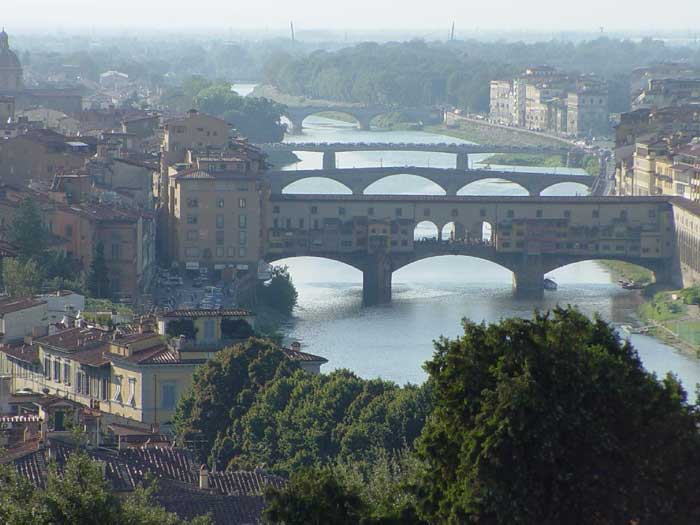 |
Ponte Vecchio
|
The Ponte Vecchio, one of the most famous landmarks of Florence, houses the best kept secret of the city. It is actually a passageway dating back to 1564.
The Grand Duke of Florence, Cosimo I de' Medici, ordered his favorite architect, Giorgio Vasari, to build a path that would allow him and the Royal family to move freely from their residence, Palazzo Pitti, to the government palace, Palazzo della Signoria, on the other side of the river Arno.
Hidden between city houses and even passing through a church, the Vasari Corridor is one of the most astounding architectural masterpieces of the Renaissance.
Art in Tuscany | The Vasari Corridor
|
|
Galleria degli Uffizi | Uffizi Gallery
|
|
|
The greatest art gallery in Italy, La Galleria degli Uffizi or the Uffizi Gallery is one of the largest museums in the world. It was built in the mid-sixteenth century, following a project by the architect Giorgio Vasari and still houses some of the most famous works of art by Italian and foreign painters from the 13th to 19th centuries, such as Tiziano, Cimabue, Giotto, Masaccio, Tintoretto, Leonardo, Botticelli, Michelangelo, Piero della Francesca, Raffaello, Caravaggio, Rubens, Rembrandt, Durer and Goya. The Gallery of the Uffizi was also the first museum ever to be opened to the public: in fact the Grand Duke granted permission to visit it on request from the year 1591. Its four centuries of history make the Uffizi Gallery the oldest museum in the world.
Building of the palace was commenced in 1560 by Giorgio Vasari for Cosimo I de' Medici as the offices for the Florentine magistrates (hence the name uffizi, meaning offices).
Art in Tuscany | La Galleria degli Uffizi | Uffizi Gallery
History
The project to arrange the Gallery on the 3rd floor of this large building, conceived by Cosimo I Medici, was realized by his son Francesco I, who, after having Buontalenti build the room of the Tribune for the collection of antique medals and other works of art, had the ceilings of the first corridor decorated so that he could place there the series of famous portraits and, above all, the valuable sculptures, that give it name of "Gallery of the Sculptures".
With the addition of the other rooms, the Gallery was enlarged with the works brought from Rome by Ferdinand I, who renounced the office of Cardinal to become Grand Duke of Tuscany in the place of his deceased brother Francesco I. The Medici, now absolute rules of the city and of Tuscany, having married into the greatest families, continuosly enriched the Gallery, as under the reign of Ferdinando II, who married Vittoria della Rovere.
Later Cosimo III had the Gallery made larger in order to house the works inherited from his uncle Cardinal Leopold. With the extinction of the Medici, the last of the family, Anna Maria Ludovica, who died in 1737, with the so called "family-pact" held in Vienna in 1737, arranged that all the art treasures gathered by the powerful dynasty forever remain at the disposal of the Florentines and of the visitors of the entire world. Thanks to this testament, it was possible to recuperate so many works of art stolen during the last war, and during the Napoleonic era, even though, unfortunately, many masterpieces remained in France.
The Lorraines, successors of the Medici, enriched the Gallery and built the beautiful room of Niobe to house the marble group called Niobe and her children struck by Apollo and Diana. After the expulsionn of the Lorraine (1859), the Gallery passed under the State and was completely reorganized according to moderm criteria.
With the reorganization that took place after the last war, not only can we more clearly admire the development of Florentine and Tuscan painting and the better observe the great benefits over the other regions, but also we can better observe the great benefits that both Italian and foreign artists obtained by coming into contact with each other, as illustrated by the Adoration of the Shepherds by Van der Goes in Room 14, placed in confrontation with works by Florentine artists who were inspired by this painting. Thus the works of Bellini confronted with those of Dürer, clerly show the fascination that the great German artist experienced on contact with the Venetian painters
Because of its huge collection, some of its works have in the past been transferred to other museums in Florence, such as some famous statues to the Bargello. In 1993, a car bomb exploded in Via dei Georgofili and damaged parts of the palace, killing five people. The most severe damage was to the Niobe room, the classical sculptures and neoclassical interior of which have been restored, although its frescoes were beyond repair. The cause has never been cleared up, although some suspect the Mafia. Today, the Uffizi is one of the most popular tourist attractions of Florence.
Collections
Here is only a small selection from the world-class collection of paintings:
Cimabue (Maesta)
Duccio (Maesta)
Giotto (The Ognissanti Madonna, Badia Polyptych)
Simone Martini (The Annunciation)
Paolo Uccello (The Battle of San Romano)
Piero della Francesca (Diptych of Duke Federico da Montefeltro and Duchess Battista Sforza of Urbino)
Fra Filippo Lippi (Madonna with Child and Two Angels)
Sandro Botticelli (Primavera, The Birth of Venus, The Adoration of the Magi and others)
Hugo van der Goes (The Portinari Triptych)
Leonardo da Vinci (The Annunciation, The Adoration of the Magi)
Piero di Cosimo (Perseus liberating Andromeda)
Albrecht Durer (The Adoration of the Magi)
Michelangelo (The Doni Tondo)
Raphael (Madonna of the Goldfinch, Pope Leo X with Cardinals Giulio de' Medici and Luigi de' Rossi)
Titian (Flora, Venus of Urbino)
Parmigianino (The Madonna of the Long Neck)
Caravaggio (Bacchus, The Sacrifice of Isaac, Medusa)
Andrea del Verrocchio (The Baptism of Christ) Address: Piazzale degli Uffizi, 50122 Firenze
Transport: Bus: Service from Santa Maria Novella Station, bus 23.
Art in Tuscany | Uffizi Gallery in Florence
|
|
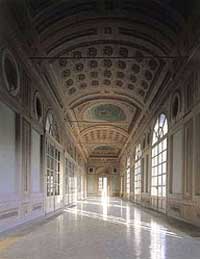
Galleria degli Uffizi | Uffizi Gallery |
|
|
|
The Arno River in Florence has flooded significantly numerous times over the centuries, but the one that took place on November 4, 1966, was one of the worst. Rising meters above normal level, the Flood of ’66 caused 36 deaths and devastating destruction of personal and public property, homes, and numerous historic works of art. All around the city are height markers on buildings that show how high the raging waters reached.
The flood that occurred on 3-4 November 1966 in the Arno river (Tuscany – Italy) has been, for this area, one of the most devastating floods.
Millions of books and documents stored in the basement of the Biblioteca Nazionale, adjacent to Santa Croce (and to the river), were submerged in oily mud; the water covered the tombs in the church and stained the frescoes by Giotto in the Peruzzi Chapel. And Cimabues famous crucifix, in the Museum of Santa Croce, was destroyed beyond hope of restoration, despite heroic attempts by the monks to salvage even the smallest bits of gold and flecks of paint from the oily muck that remained when the water had subsided. In the words of Sir Kenneth Clark (in The Nude) the Cimabue crucifix marked a return, after the middle ages, to a conception of the human body as "a controlled and canonized vehicle of the divine".
Thirty years later the panels from the Baptistry have been moved to safety in the Museum of the Duomo; the damaged Cimabue crucifix is now suspended on chains from the ceiling in the Santa Croce museum so that it can be raised in case of another flood; the state archives have been moved from the basement of the Uffizi to Piazza Beccaria [1]
Forty years after the catastrophic flood in Florence, Italy of November 1966, a symposium was held at New York University's Villa La Pietra to commemorate the conservation efforts of the international community. Many of the invited speakers were those who had participated directly in the recovery of damaged works of art. |
|
The high water marks for the floods of 1557 and 1966, which can be seen above your head on the north side of the piazza (just around the corner from the Via Verdi) are astonishing.
|
Thousands of young people from around the world converged on Florence to offer their services. Known as angeli del fango, or mud angels, they went down into the cellars of the city and carried out buckets of oily mud that had been deposited by the Arno. In the cellars of the Bibliorcca Nazionale they had to wear gas masks because of the poisonous fumes given off by sewage and by the decomposing leather bindings of the books; but they rescued thousands and thousands of books and documents, which were perhaps the most serious casualties of the flood.
|
|
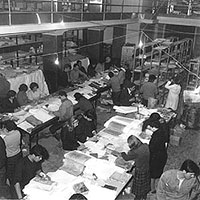 |
|
|
![]()
![]()
![]()
![]()
![]()

